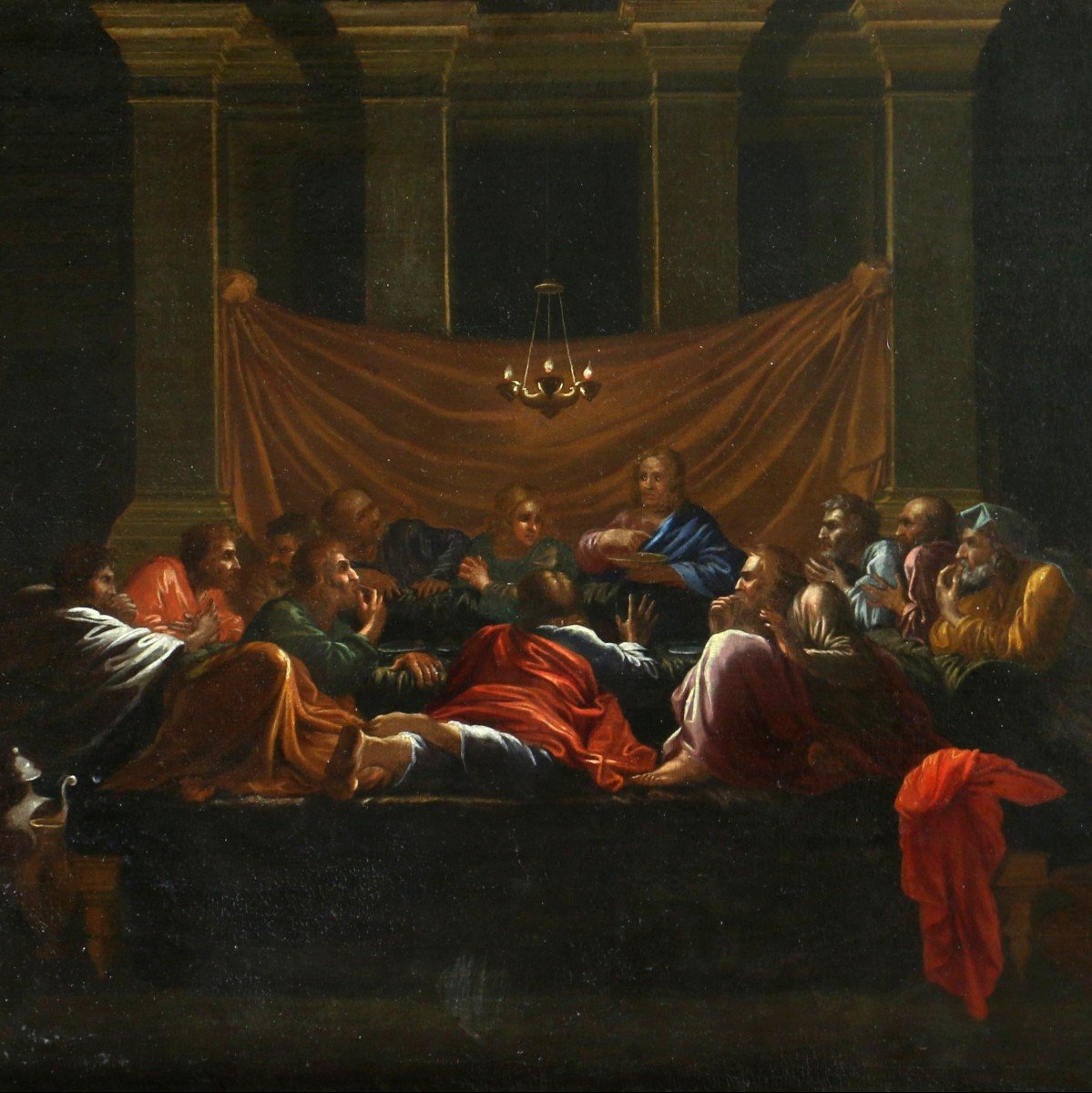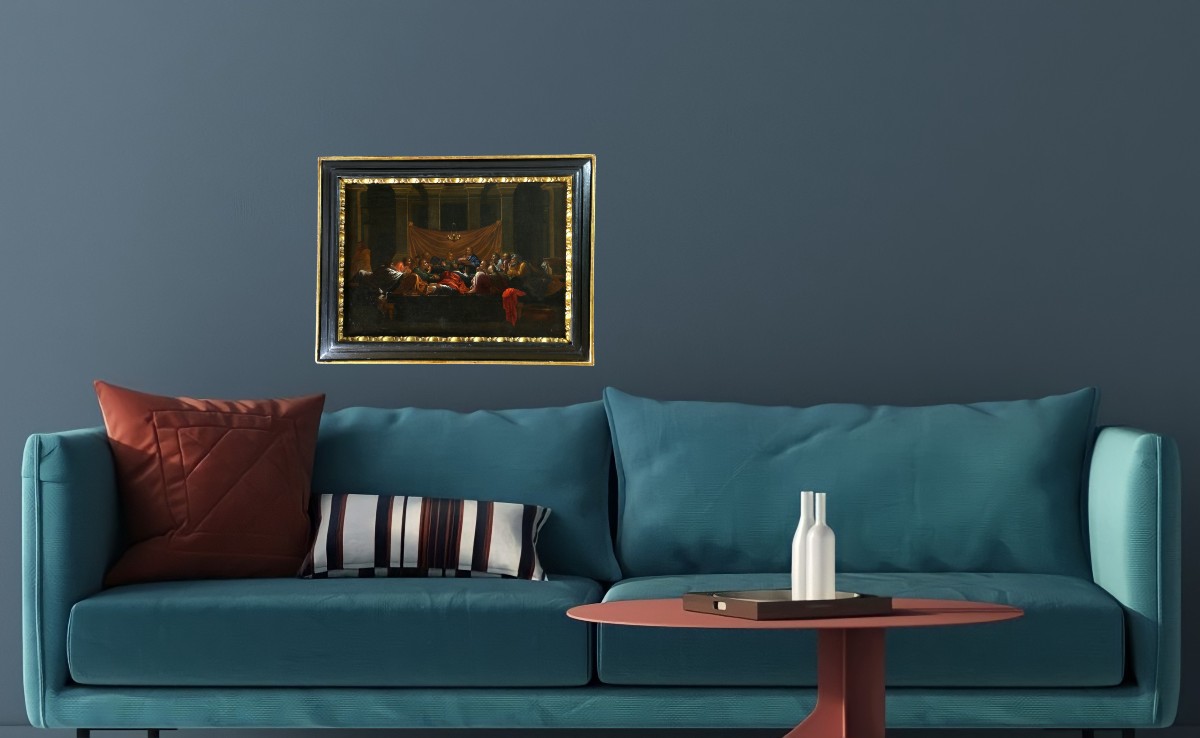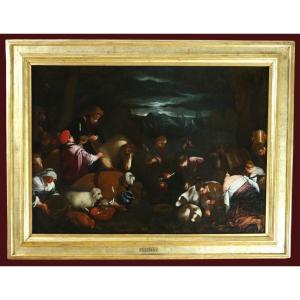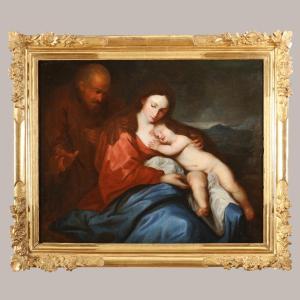Re-lined canvas measuring 77 cm by 54 cm
Old 17th century frame measuring 94 cm by 71 cm
Nicolas Poussin painted The Last Supper titled The Eucharist, which he executed in two different versions. Once between the years 1636-1640 (present to this day in the collection of the Duke of Rutland at Belvoir Castle) and the second in 1647 for Paul Fréart de Chantelou (present to this day in the collection of the Duke of Sutherland, exhibited at the National Gallery of Scotland). Our table is according to this second version. In this work, Nicolas Poussin moves away from the traditional iconography of the Last Supper. He sets the scene in an austerely classical space, with bare stone floors and walls. Christ and his disciples are placed around an oval table, which Poussin included to emphasize the sacrament of the Eucharist. Christ is in the center of the composition with John the Evangelist to his right and Judas Iscariot to his left. Christ is shown blessing the bread and wine, which are offered to him by an angel.
It is possible that our painting is a version painted by the French painter Nicolas de Plattemontagne (1631; 1706).
This very beautiful work benefits from a superb 17th century frame.
Nicolas Poussin (1594; 1665)
French painter of the 17th century, he is one of the major representatives of pictorial classicism/ He was born in the hamlet of Villers, in the commune of Andelys, and died on November 19, 1665 in Rome. Trained in Paris, he worked mainly in Rome from 1624. He painted historical, religious and mythological scenes, as well as landscapes animated with characters. Although he responded to a few commissions intended for churches, he is best known for medium-sized paintings intended for a few Italian or French amateurs to whom he remained faithful throughout his life. His fame allowed him to become painter to the king and to return to France between 1640 and 1642. He ultimately preferred to return to Rome where he resided until his death. Poussin is one of the greatest classical masters of French painting and, although he had very few students, his influence on it is considerable, during his lifetime and to the present day. Between 220 and 260 paintings are attributed to him, as well as nearly 400 drawings. Nicolas Poussin discovered his artistic vocation through contact with the Mannerist painter Quentin Varin. In 1612, he arrived in Paris, where he worked in the workshop of Lorraine Georges Lallement, also a Mannerist, then, in 1622, he collaborated with Philippe de Champaigne in Luxembourg . He also met the poet Giambattista Marino, who introduced him to a taste for the antique. After a stay in Venice, it was in 1624 that Poussin went to Rome, the artistic capital of the time. Thanks to Marino, he lives in the entourage of powerful collectors. For Cardinal Francesco Barberini (1597-1679), nephew of Pope Urban VIII, he executed the Death of Germanicus (1627, Minneapolis), his first masterpiece as a history painter. The most important of his clients, however, was the cardinal's secretary, Cassiano dal Pozzo (1588-1657), to whom he became the "philosopher painter" of European reputation. Recovering from a serious illness, Poussin married in 1630 the woman who had taken care of him, Anne-Marie Dughet, the daughter of a French cook living in Rome. He will, from then on, ensure the artistic training of his brother-in-law, Gaspard, who will become an excellent landscaper. Coming to Paris in December 1640, at the urging of Richelieu, Nicolas Poussin was appointed first painter to the king. But his euphoria was short-lived. He realized that he was not made for what was expected of him: large altar paintings, vast allegorical paintings and, above all, decorative work on the great gallery of the Louvre (never finished and later destroyed). ). The intrigues of painters who feared for their position, led by Simon Vouet, added to Poussin's discontent. He decided to return to Rome in September 1642. In principle, he was going to look for his wife there. In reality, he had no intention of leaving, especially after the deaths of Richelieu and Louis XIII. The enlightened amateurs met in Paris such as Paul Fréart de Chantelou remained faithful to him.






































 Le Magazine de PROANTIC
Le Magazine de PROANTIC TRÉSORS Magazine
TRÉSORS Magazine Rivista Artiquariato
Rivista Artiquariato